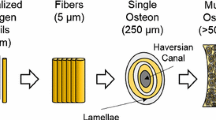Abstract
Fracture analysis of a cortical bone sample from a tibia of a 70 years-old human male donor is conducted computationally using an extended finite element method. The cortical bone microstructure is represented by several osteons arranged based on bone microscopy image. The accuracy of results is examined by comparing a linear elastic fracture mechanics approach with a cohesive segment approach and varying the finite element model mesh density, element type, damage evolution, and boundary conditions. Microstructural features of cortical bone are assumed to be linear elastic and isotropic. We find that the accuracy of results is influenced by the finite element model mesh density, simulation increment size, element type, and the fracture approach type. Using a relatively fine mesh or small simulation increment size gives inaccurate results compared to using an optimized mesh density and simulation increment size. Also, mechanical properties of cortical bone phases influence the crack propagation path and speed.
















Similar content being viewed by others
References
ABAQUS V6.13 theory guide. http://abaqus.software.polimi.it/v6.13/books/stm/default.htm
Abdel-Wahab A, Maligno A, Silberschmidt V (2012) Micro-scale modelling of bovine cortical bone fracture: analysis of crack propagation and microstructure using X-FEM. Comput Mater Sci 52:128–135
Ager JW, Balooch G, Ritchie RO (2006) Fracture, aging, and disease in bone. J Mater Res 21:1878–1892
Bayraktar H, Morgan E, Niebur G, Morris G, Wong E, Keaveny T (2004) Comparison of the elastic and yield properties of human femoral trabecular and cortical bone tissue. J Biomech 37:27–35
Budyn E (2006) Multi-scale modeling of human cortical bone: aging and failure studies. Mater Res Soc Symp Proc 975:27–32
Budyn E, Hoc T (2010) Analysis of micro fracture in human Haversian cortical bone under transverse tension using extended physical imaging. Int J Numer Methods Eng 82:940–965
Budyn E, Hoc T, Jonvaux J (2008) Fracture strength assessment and aging signs detection in human cortical bone using an X-FEM multiple scale approach. Comput Mech 42:579–591
Budyn E, Jonvaux J, Funfschulling C, Hoc T (2012) Bovine cortical bone stiffness and local strain are affected by mineralization and morphology. J Appl Mech 79:1–12
Giner E, Arango C, Vercher A, Fuenmayor FJ (2014) Numerical modelling of the mechanical behaviour of an osteon with microcracks. J Mech Behav Biomed Mater 37:109–124
Feerick Emer M, Liu XC, McGarry P (2013) Anisotropic mode-dependent damage of cortical bone using the extended finite element method (XFEM). J Mech Behav Biomed Mater 20:77–89
Idkaidek A, Jasiuk I (2016) Cortical bone fracture analysis using XFEM–case study. Int J Numer Methods Biomed Eng 33(4):e02809
Jonvaux J, Hoc T, Budyn É (2012) Analysis of micro fracture in human Haversian cortical bone under compression. Int J Numer Methods Biomed Eng 28:974–998
Mischinski S, Ural A (2013) Interaction of microstructure and microcrack growth in cortical bone: a finite element study. Comput Methods Biomech Biomed Eng 16:81–94
Nalla R, Stölken J, Kinney J, Ritchie R (2005) Fracture in human cortical bone: local fracture criteria and toughening mechanisms. J Biomech 38:1517–1525
Nobakhti S, Limbert G, Thurner P (2014) Cement lines and interlamellar areas in compact bone as strain amplifiers—contributors to elasticity, fracture toughness and mechanotransduction. J Mech Behav Biomed Mater 29:235–251
Pattin CA, Calet WE, Carter DR (1996) Cyclic mechanical property degradation during fatigue loading of cortical bone. J Biomech 29:69–79
Ural A, Mischinski S (2013) Multiscale modeling of bone fracture using cohesive finite elements. Eng Fract Mech 103:141–152
Zimmermann Elizabeth A, Launey ME, Barth HD, Ritchie RO (2009) Mixed-mode fracture of human cortical bone. Biomaterials 30:5877–5884
Acknowledgements
This research was partially supported by the National Science Foundation DMR Program Grant 15-07169 and the Blue Waters sustained-petascale computing project at NCSA. The Blue Waters is supported by NSF awards OCI-0725070 and ACI-1238993, and by the state of Illinois. The findings, conclusions, and recommendations expressed in this manuscript are those of the authors and do not necessarily reflect the views of the NSF.
Author information
Authors and Affiliations
Corresponding author
Rights and permissions
About this article
Cite this article
Idkaidek, A., Koric, S. & Jasiuk, I. Fracture analysis of multi-osteon cortical bone using XFEM. Comput Mech 62, 171–184 (2018). https://doi.org/10.1007/s00466-017-1491-3
Received:
Accepted:
Published:
Issue Date:
DOI: https://doi.org/10.1007/s00466-017-1491-3




